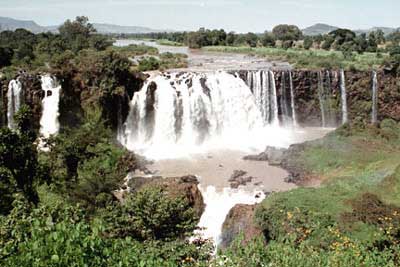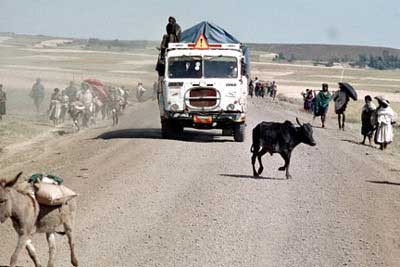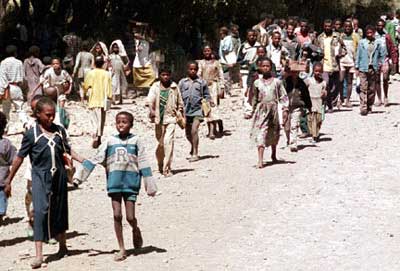By Marie Javins

“Denial ain’t just a river in Egypt. It’s in Ethiopia too.”
This occurred to me while I stared at Ethiopia’s Tis Abay— the Blue Nile Falls — near Lake Tana’s colorful monasteries and the Ethiopian source of the Nile.
Most people think of pharaohs, pyramids, and feluccas when they think of the Nile, but the world’s largest river starts in Uganda and Ethiopia then goes on to visit Sudan before reaching Egypt.
Tis Abay is the first site along Ethiopia’s Historical Route, a loop that begins in Addis Ababa and goes through Bahir Dar, Gonder, Axum and Lalibela before returning to the capital. It’s the only natural site along the route.

Ethiopia, inaccurately renowned as a famine-stricken desert country, has massive green mountains, unique birds and animals, and stunning landscapes.
Other Stone Churches
But the monasteries of Bahir Dar’s Lake Tana, the archeological sites at Axum, the stone-hewn churches of Lalibela, and the 17th-century castles of Gonder overshadow not just nature but also other stone churches, the hyena-feeding men of medieval Harar, the thriving Tigrayan capital of Mekele, the tribes of the Omo Valley, and the unlauded jewel in the crown — the rich, undiluted Ethiopian culture.
Ethiopia, most famous for being the recipient of 1985’s We Are the World fundraising campaign, has suffered from its infamy. With so many astonishing historical and natural sites, Ethiopia has tourism potential worthy of Egypt or Rome. But instead of being known for 2,000-year-old obelisks, 12-century churches quarried from volcanic rock, Abyssinian lions, and a 3.5 million-year-old human skeleton, Ethiopia is known for droughts and starving children.
Tourists, instead of asking if there are campgrounds in the World Heritage Simien Mountains, discreetly inquire if Ethiopian Airlines serves food.

Tourism brings in sustainable income and can genuinely help Ethiopia in a way that foreign aid cannot.
And fortunately, the secret of Ethiopia’s Historical Route is starting to leak out. It’s recently been featured in both Transitions Abroad and in the UK’s Wanderlust magazine.
Late in 2000, Lonely Planet put out its first guide to the African Horn, and Bradt has just released a third edition of the Philip Briggs classic guide to Ethiopia.
Writer Paul Theroux visited Ethiopia for his book Dark Star Safari. A trickle of intrepid backpackers, en route from Cairo to Cape Town has led the charge, but more and more tour companies are introducing small-group trips to the main sites along Ethiopia’s Historical Route.
Welcome to Ethiopia

A Dragoman overland truck had brought me north from Kenya to Ethiopia. On our first night in Ethiopia, the trip leader gave our group of eight a rundown of what to expect.
“When you hear children scream YOU YOU YOU at you, it means nothing. They are just excited to see you, and it is the English equivalent of something not impolite in Amharic. Don’t be offended by it.
“The same goes for the word faranji. It means foreigner, and they use it to describe you. It is not meant as an insult.
“Also, cover your shoulders, no short shorts, and no public farting. It is a major rule here.
“Ethiopia is a tough country to travel in, but it is also a rewarding country. Some say it is the India of Africa. For those of you who have been to India, that may mean something.”
It meant a lot to me. India had been a challenge.
Lush Green Hills

We drove north towards Addis Ababa. Lush, green hills surrounded our single ribbon of asphalt, and it was hard to reconcile the fertile land around us with our preconceptions of a famine-stricken country. Occasionally, small drab towns would surround the road with cement-block single room homes that were open in front. People, goats, dogs, and donkeys covered the road, oblivious to any vehicle right-of-way rules.
Children in surplus Titanic t-shirts chased our truck and screamed “YOUYOUYOU FARANJI” at us, waving enthusiastically. A few got so excited they threw rocks in the air, and occasionally in our direction. Guidebook writer Philip Briggs calls it “faranji hysteria” while Lonely Planet calls it “faranji frenzy.”
It is exclusively a rural phenomenon. In cities, especially in relatively cosmopolitan Addis Ababa (the home of the UN’s “Economic Commission for Africa”), faranjis are a common site.
The Benefits of Group Travel
As we made our way north from Bahir Dar to Gonder, the advantages of group travel in Ethiopia became clear. Our trip leader was a familiar, respected face in Ethiopia. His regional knowledge took us to inexpensive local inns and restaurants, instead of government-run hotels.
And traveling in a big Mercedes tourist bubble had one major advantage. It was a buffer zone, where us weary tourists could retreat from the dozens of excited children screaming YOUYOUYOU. It was a place to rest when we tired of being constantly greeted, constantly assisted, and constantly escorted by well-meaning new friends. And more importantly, it gave us a respite from the confusion and guilt we felt after frequently being asked for money.
An Intact Culture in Ethiopia
Ethiopia is one of the few African nations whose culture is intact due to historical isolation. Aside from a brief period of Italian occupation under Mussolini (which the Ethiopians fiercely resisted), Ethiopia was never colonized. Its culture is unique, ancient, and dazzling, with music, food, drink, and religious ceremonies seen nowhere else on earth.
But one could argue that a different kind of colonization has taken place since the 80’s influx of foreign aid. Some tourists complain of being mistaken for walking ATMs, and people deal with the demands on their wallets in different ways.
In his Guide to Ethiopia, Philip Briggs suggests that perhaps some recipients of foreign aid do not distinguish between an aid organization and the individual tourist. He also points out that indiscriminate giving of trinkets assuages only the guilt of the giver, and that the way for tourists to truly aid Ethiopians is by patronizing local businesses.
Ethiopia’s Camelot

In Gonder, two young Ethiopian students — Peter and Ababa — befriended me.
“Why,” I asked them, “does everyone ask for pens?” Children requesting pens is common in, but by no means exclusive to Ethiopia.
“For schoolwork,” was their response.
“What if,” I suggested, “the tourist gives a box of pens to the teacher?”
“Then the teacher will keep them.”
They took me to see the last Felasha Jew in Gonder, and then escorted me back to the hotel. They asked me to send Bob Marley cassettes when I could. Reggae is popular in Ethiopia, and Jamaican Rastafarianism began when Ras Tafari became Emperor of Ethiopia in 1930, adopting the name Emperor Haile Selassie.
In the morning, our Dragoman group excursion was to the Royal Enclosure, Fasilada’s Bath, and the Debre Berhan Selassie Church.
Emperor Fasilada was the man credited with constructing most of the 300-year-old palaces and buildings, at a time when Gonder was the capital of Ethiopia. War, invasions, and time have destroyed many. Most of the best-kept remaining castles, stables, churches and towers are within the Royal Enclosure.
Fasilada’s Bath is just over a mile away. It’s an atmospheric compound featuring a sunken pool surrounding a small castle. The lake is filled at Timkat, the three-day Ethiopian Orthodox Church festival that occurs in January. After a ceremony, celebrants jump into the lake to commemorate Christ’s baptism by John the Baptist.
Our last stop in Gonder was the Debre Berhan Selassie Church, the only original Gonder church to escape destruction at the hands of the Dervish of Sudan in the 19th-century. Legend has it that a swarm of bees saved the church. The bees were surely great art-lovers, as the colorful 17th-century frescos on the walls and ceilings of the church are among the finest in a country where even the smallest church features colorful paintings.
On Lake Tana, every small monastery we’d visited featured bright depictions of Biblical scenes, extending to chapters not seen outside of Ethiopia. The Debre Berhan Selassie Church is not round like the churches in much of the country. It is rectangular, as legend has it that the church was built to house the rectangular Ark of the Covenant.
Axum: Home of the Ark

Ethiopians do not doubt that the Ark is in Ethiopia, but it is not in Gonder. Its resting place is not even a chuch, but is a secure building in Axum’s St. Mary of Zion church compound. Ethiopia’s Biblical epic, the Kebre Negast, recounts the legend of how the Ark came to Axum. Graham Hancock’s The Sign and the Sea is a modern book that examines and disproves aspects of the legend, but suggests that Ethiopia’s claim is somewhat credible.
The Ark legend aside, Axum has plenty of concrete reasons to merit a visit. Hundreds of tombs and granite obelisks — called stelae — dot ancient archeological sites. Less than five percent of them have been excavated. The Northern Stelae Field alone has over 120 carved monoliths, which were reputedly raised by the power of the Ark. Archeologists, however, argue that elephants, rollers, and winches were responsible for erecting the 2000-year-old stelae.
Independent Travel to Lalibela
“Do you know the difference between faranjis and Ethiopians?” The shopkeeper of a bookstore/cybercafe addressed my friend Monica on our first night of traveling away from the Dragoman group. We were en route to Lalibela and had caught an early bus from Axum to the upscale Tigrean capital of Mekele, arriving after a quickly-repaired breakdown.
“Mmm… no. What?”
“When faranjis go out for coffee, they all pay separately.”
He laughed uproariously, either at his joke or the absurdities of faranjis. Ethiopian custom is that the individual who does the inviting always picks up the tab.
The next morning, bus officials ushered us through the bus park gate before the six a.m. opening time. No one complained. Faranjis were, not unjustly, considered incapable of fending for themselves against the anxious locals gearing up for the mass sprint to the buses. Buses fill quickly, and Ethiopian law states that all passengers must have a seat, although this rule is often ignored in rural areas.
Ethiopian Pop Music
We headed out, the sounds of an Ethiopian cassette playing through a tinny speaker above the bus driver’s head. Ethiopian pop music is far more popular in Ethiopia than Western acts. In this instance, it sounded like the music we’d seen in Addis Ababa as part of an Azmari Beats variety-style show. Imagine the war cry of Xena: Warrior Princess set to music.
Our trip took all day due to a leaky radiator and Chinese-sponsored road construction. And our next day’s trip quit being inconvenient and devolved into absurdity when a four-hour ride by Land Cruiser turned into a hitchhiking epic that finally put us in Lalibela after a disastrous overnight cargo truck ride over a pitted dirt road.
Medieval Lalibela, the final stop along the Historical Route, was worth the effort. Some Ethiopians believe that Lalibela’s churches were built by angels — and why not? Like the pyramids of Egypt, the 800-year-old structures seem too grand, too perfect to be manmade. They are subterranean, hewn straight out of solid red rock, connected by tunnels and catacombs. There are at least 11 unique, active shrines, visited more by devoted pilgrims than by tourists.
Lalibela’s churches, along Ethiopia’s River Jordan, are a testament to the devotion of Ethiopia’s Orthodox Christians that have long dominated half (or more) of the country. Ethiopian Christianity is rooted in ancient Judaism, and because Ethiopia had little contact with other Christian countries, its religions evolved in their own undiluted, Old Testament-inspired ways. Indigenous Felasha Jews operated in a similar void until nearly all were airlifted to Israel during the ’80s and ’90s.
The most famous of Lalibela’s churches is the Church of St. George. After Jesus and the Virgin Mary, St. George is the most popular biblical character in Ethiopia. Various interpretations of him slaying the dragon abound throughout the Christian part of the country, and paintings of him adorn the walls of Lake Tana monasteries. He is said to have visited his Lalibela shrine, and my guide pointed out his horse’s hoofprints on the wall.
Later, I caught an Ethiopian Airlines flight back to Gonder, while Monica waited for the group to meet her at Lalibela. The trip had taken several days by road, but was a comfortable hour by Africa’s oldest airline. Independent bus travel in Ethiopia had been arduous but rewarding.
Monica and I were thrilled to be squashed in with locals, interacting on a personal level, and sharing meals with strangers. But tourists with time constraints (or back problems) would do better to take the inexpensive daily Historic Route service offered by Ethiopian Airlines. Tickets are available in Ethiopia, or from Ethiopian Airlines New York or Washington offices.
Leaving by Land
Word has been getting out that there’s a lot to see in Ethiopia, and tourist numbers, though still small, have increased. Most tourists fly in and out of Addis Ababa, with its international airport, diverse restaurants and upscale hotels.
But some travel overland from Nairobi, seeing game parks and tribes along the way. And a backpacker’s route is evolving overland to Egypt through northern Sudan, via Gonder, Shihedi, Metema, and Gedaref on the Sudanese side.
I took the sparsely -traveled overland route to Egypt, and so on a late October afternoon found myself sitting in a tiny blue-and-pink concrete hotel in Shihedi. I ordered dinner, along with an Ambo, Ethiopia’s superb brand of mineral water. It was one of two weekly “fasting” days, which meant that only vegetarian food was available.
Ethiopian cuisine, spicy meats or pureed vegetables served on flat injera gluten-free bread that doubles as utensils, is a “love-it-or-hate-it” food, and I loved it. The sound of a pool cue clicking on balls came from next door, and the Xena war-cry in the distance indicated that a sporting event was on, or perhaps the girls’ choir was practicing.
I relaxed with my shiro-wot, and answered questions posed by curious locals. Yes, I was alone. Yes, I liked Ethiopia. Yes, I often traveled alone and preferred it that way.
But this time I was lying. Group travel had been the ideal way to see Ethiopia and now I was lonely. I’d enjoyed being able to retreat to the group when the squeals of children had overwhelmed me. And our group had behaved well. We’d adapted to the onslaught of “YOUYOUYOU” children, had dressed conservatively so as not to offend, and hadn’t raised a fuss when the women of our group had been forbidden from certain male-only monasteries on Lake Tana. And best of all, no one had farted in public.
WEATHER
Rainy season is mid-June to mid-September. If traveling independently by road, avoid during this time as remote roads may be impassable. The Blue Nile falls are more impressive during or right after rainy season.
CALENDAR AND TIME
The Ethiopian calendar is 7.5 years behind the Western Gregorian calendar. Time is told on a 24 hour clock that begins at daybreak. 6 a.m. is the start of the Ethiopian day, so 7 a.m. is “one,” 8 a.m. is “two,” and so on.
PHOTOGRAPHY
Steep fees are charged for video cameras at historic sites. Avoid using a video camera for still shots if you do not want to pay the fee. Still cameras are treated with extreme suspicion outside of historic sites. They are not allowed in many public buildings such as post offices, banks, and even some department stores.
INTERNET ACCESS
Cybercafes exist in Addis Ababa, Bahir Dar, Gondar, and Mekele. Service in Addis Ababa is slow, but outside of Addis Ababa it is excruciatingly slow and expensive. Electricity is unreliable.
Marie Javins is a cartoonist who has worked for Marvel comics and others, she lives in Los Angeles.
- These 9 U.S. National Parks Require Reservations in 2024 - April 17, 2024
- Take a Hike in Olympic National Park - April 17, 2024
- The Wild Mississippi: 2340 Miles Across Ten States - April 8, 2024






This was an interesting post to read. I definitely enjoyed perusing over it. Did you only get to visit historical sites while you were in Ethiopia? I’ve heard they have beautiful natural sites as well that attract many visitors such as the Blue Nile Falls and the Danakil Depression. Ethiopia seems like a country with a lot to offer its tourists and not just the regular wildlife safari. Happy travels to you!